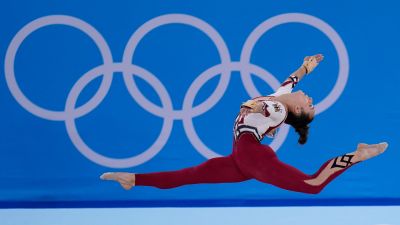Tokyo 2020: Germany's Olympic women's gymnastics team ditch leotards for less revealing unitards

The German women's gymnastics team have ditched leotards for less revealing unitards as female athletes continue to hit back against objectification and policing of sportswomen's bodies.
For decades, female gymnasts have worn bikini-cut leotards but in qualifying on Sunday at Tokyo 2020 Olympic Games, the German team wore unitards that stretched to their ankles.
In contrast to the women's uniform, male gymnasts wear comparatively body-covering clothes - vest tops with loose shorts for their floor exercise and vault, and long leggings on bar and pommel horse routines.
The German team first wore unitards at the European Artistic Gymnastics Championships in April.
Germany's Sarah Voss said the team wasn't sure it would decide to wear them again during Olympic competition until they got together before the meet.
“We sat together today and said, 'OK, we want to have a big competition',” the 21-year-old said.
“We want to feel amazing, we want to show everyone that we look amazing.”
Their wardrobe revolution, while widely championed, has not so far started a trend.
The 4ft 8" American superstar Simone Biles said in June that she prefers leotards because they lengthen the leg and make her appear taller.
“But I stand with their decision to wear whatever they please and whatever makes them feel comfortable,” Biles said.
“So if anyone out there wants to wear a unitard or leotard, it’s totally up to you.”
The German team's uniform does comply with the wardrobe rules of the International Gymnastics Federation, unlike the Norwegian woman's beach handball team who were fined €1,500 (£1,298) for wearing “improper clothing” when they opted for shorts instead of the usual bikini bottoms during the European Beach Handball Championships in Varna, Bulgaria.
During the gymnastics qualifying on Sunday, the announcer called the outfits “very nice indeed".
Meanwhile, the head of broadcasting at the Tokyo Games is trying to banish overly sexualised images of female athletes.
“You will not see in our coverage some things that we have been seeing in the past, with details and close-up on parts of the body,” Olympic Broadcasting Services chief executive Yiannis Exarchos said on Monday.
The International Olympic Committee does not govern those kinds of rules for individual sports, but it does run the Olympic Broadcasting Service and controls the broadcast output from Tokyo shown to the world.
“What we can do is to make sure that our coverage does not highlight or feature in any particular way what people are wearing,” Exarchos said.